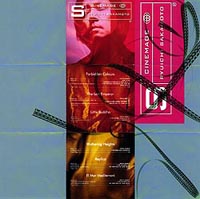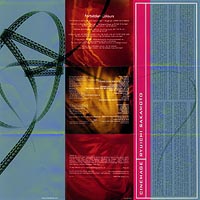











 |
 |
 |
 |
 |
 |
 |
 |
 |
 |
 |
 |
| back to main index | |||||||||||
| update - new release |


Cinemage. It is an intriguing syncretism and the ideal title for this album, a collection of pieces that Ryuichi Sakamoto composed mostly as aural accompaniment to visual events - but that exist on their own as pure music, evocative and compelling without any external program. "The Last Emperor," "Little Buddha," "Wuthering Heights" and "Forbidden Colors" (Merry Christmas, Mr. Lawrence) are some of Sakamoto's most renowned themes, each evidence that he is one of the more memorable melodists working today. And these compositions - along with the epic "El Mar Mediterrani" (written for the opening ceremonies of the 1992 Barcelona Olympic Games) and the rarely heard "Replica" (which originated on Musical Encyclopedia, one of Sakamoto's genre-defying solo albums) - are an ideal introduction to the art of a composer who revels in the polyglot Zeitgeist that marks the end of our century.
Classically trained yet a pioneer of techno-pop, at home in the scoring studio but an adept live performer - Sakamoto pursues an uncommonly diverse muse, one attuned to the times but in touch with the thread of history. In his orchestral, chamber and solo piano pieces, one hears echoes of Debussy and Satie, Stravinsky and Messiaen, minimalism and musique concrete. And the immediacy that is such a feature of Sakamoto's work reflects his veneration of such masters as Brian Wilson, Bill Evans and Joao Gilberto, as well as his affection for the folk music of the Pacific islands and his native Japan.
Born in 1952 in Tokyo, Sakamoto was taught from an early age by Taminosuke Matsumoto (a devotee of Hindemith), and he graduated from Tokyo National University for the Fine Arts & Music with a concentration in electronic and ethnic music. Inspired by Kraftwerk's proto-electronica, Sakamoto co-founded Yellow Magic Orchestra in the late '70s and went on to sell millions of albums and fill stadiums throughout Asia with the band. Since then, he has lived in New York and Tokyo, pursuing a dual career: As a producer and performer, Sakamoto has retailed a sophisticated brand of one-world pop, collaborating with artists from Youssou N'Dour to Iggy Pop. And his soundtracks have made Sakamoto one of the world's most successful film composers not immersed in the Hollywood machine. Sakamoto's music for Bernardo Bertolucci's epic Chinese tragedy The Last Emperor earned 1987 Oscar(R) and Grammy awards among its slew of honors, and his recent score to Brian DePalma's Snake Eyes managed to channel the ghosts of both Mahler and Miles Davis in the cathartic mini-symphony of its final cue.
Sakamoto likes to tell of directing the orchestra in the studio for The Last Emperor soundtrack with Bertolucci exhorting "More emotionale! More emotionale!" Indeed, emotion is what resonates in this dramatic piece, as East meets West in characteristic Sakamoto fashion. The poignant, Asian-inflected melody is refracted through the sweeping textures of a Romantic orchestra, twining to a grand denouement. As with the balance of Cinemage, this gritty performance was recorded on Sakamoto's "f" tour of Asia in early 1997, with Sakamoto leading the 70-piece orchestra from the piano along with conductor Yutaka Sado. The same tour produced the ambitious "Untitled 01," a 55-minute, four-movement work for orchestra, piano, ambient guitar, electronics and spoken word that was released in 1998 on the Sony Classical album Discord.
In the same emotive, Bertoluccian vein as The Last Emperor theme, "Little Buddha" begins with slow, somber strains redolent of Barber's "Adagio." Although instead of the shuddering finality of that great lament, Sakamoto instills a sense of hope with the aspirational atmosphere of the Francophone middle section. Darkness has fallen in this piece, yet the sun will rise again (a tone befitting a film revolving around the concept of reincarnation). Very much in the pathetique mode, "Wuthering Heights" boasts one of Sakamoto's most gloriously Romantic tunes, full of enough autumnal longing to do Tchiakovsky or Elgar proud. With "Replica," we enter an entirely different sound world, a realm of cyclical rhythms and minimalist harmony. As orchestrated by Koichi Suzuki from Sakamoto's early keyboard piece, "Replica" has a simple, hypnotic grace - a haiku for orchestra.
On a far grander scale is the swirling "El Mar Mediterrani," which begins with tolling fanfares and pulsating drums as it invokes a sense of occasion. As it follows, this episodic piece goes far beyond the typically rousing Olympiad theme in the range of sensations it conjures. Having fallen in love with Barcelona - from the architecture of Gaudi and the music of Mompou to the intrepid dance company Fura dels Baus that participated in the opening ceremonies - Sakamoto penned an Impressionistic soundtrack to a majestic spectacle, with hints of Catalan color, nods to Debussy's "La Mer" and shades of Sakamoto's past work coming together in a whole of energy and spirit.
Finally, the emotional centerpiece of Cinemage is one of Sakamoto's most affecting and acclaimed creations: "Forbidden Colors," the theme song to Nagisa Oshima's 1983 film Merry Christmas, Mr. Lawrence (which also showcased Sakamoto in a starring role). In addition to the original electronic version of the score, Sakamoto has recorded the theme in renditions for solo piano (on his album Coda) and piano trio (on the superlative 1996). But the poetic version here, with lyrics and vocals by English avant-pop auteur David Sylvian, is by far the best known, as it was featured in different performances on the Merry Christmas, Mr. Lawrence soundtrack album and adorned Sylvian's 1987 masterpiece Secrets of the Beehive. Typically, it is Sakamoto's heartrending melody that makes this piece communicative in whatever guise. With its Schubertian songfulness incorporating an atmospheric Japanese folk motif, "Forbidden Colors" summons the pathos of the film, a tale of tortured emotions among British captives and their Japanese wardens in a World War II prisoner-of-war camp. But as with much of Sakamoto's music, the song has a power that transcends its original context - it serves as accompaniment to an ever-manifold theater of the mind, theater of the heart.
-- Bradley Bambarger
|
| © 2010 KAB America Inc. | |||||||||||
| terms of use |